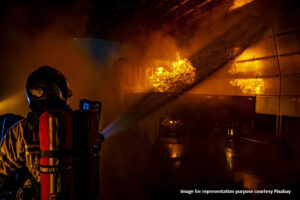
The new Fire Safety Bill passed in the Maharashtra Assembly is comprehensive and brings in several key provisions – both in terms of compliance and punitive measures – and has important ramifications for Mumbai. A look at the Bill and some of its important provisions
Over the last few years, the fire protection industry has been defined by large-scale regulatory shifts. The most noteworthy of these has been the Fire Safety Bill passed in the Maharashtra Legislative Assembly in June last; but it’s timing is also remarkable for two factors that make for an interesting happenstance. The passage of the much overdue bill came close on the heels of National Safety Week in March and an anguished Bombay High court pulling up the state government two days ago for delay in notifying safety rules post the Girgaum fire.
While the apex court in a bid to curb man-made disasters such as fire outbreaks in vulnerable buildings questioned the recommendations of the Expert Committee (constituted on court’s own orders) kept in abeyance since February 2023, the Fire Safety Bill and its provisions merit a serious attention.
With rising population density, growing urbanization, and infrastructure, metros and towns are becoming hotbeds for fire hazards. Fire can destroy everything in a blink of an eye. Laws and regulations have the highest power to influence systems and decision-makers to ensure the safety of the citizens. But even as these make all the right noises, much will depend on how rigorously the provisions are implemented. The High Court’s annoyance stems from the fact that the expert body’s recommendations are already available with the government and they only need to be notified. Why the delay in initiating the process?
Parking lots safety
An interesting amendment to the Maharashtra Fire Prevention and Life Safety Measures Act will allow a rise in the height of the professional educational institutions and parking lots to 45 metres and 100 metres respectively. It cleared the decks for high-rise parking lots of up to 35 storeys and professional colleges up to 15 storeys in Mumbai, Pune and surrounding areas. Experts, however, have raised red flags over the fire safety of the building around these parking lots that would have inflammable fuel.
The height of the parking lots coming as part of the residential tower, however, cannot exceed the height of the building. The amendment in the bill allowing taller parking lots is being justified as an answer to the space crunch in city. One wonders if the rise in the height is acceptable in cities like Mumbai where the density of population is high. A fire could be disastrous for the vicinity buildings as there is no restriction on the distance between buildings around it. The wind velocity may pose risk to the other buildings.
There is also considerable concern that any incident in any such multi-storey parking could cause an inferno with fuel-filled vehicles around. The taller the parking lot, the riskier it would be from a fire safety point of view. The moot point is, can parking space crunch in the city rationalize the risk to lives?
The permission for the parking lots to go vertical comes from the need to overcome the parking crunch in the city. Though lots are allowed to be up to 100 metres, only a few will be stand-alone and most of them are expected to be along the high rises. This means their society will have to maintain it following stringent norms. Compliance and strict monitoring could be an issue, but it all depends on the due diligence of the people responsible for it.
The new bill makes it mandatory to have an IOT-enabled system which will have to be monitored by Building Management System (BMS) round the clock. The sensor-based system will monitor the water level in tanks, the condition of fire pumps near the water tank, the alarm system and the sprinkler system among others. The fire brigade will get alerts about the shortages and appropriate action will be taken against the societies. The use of new technology, maintenance and monitoring of the firefighting system can effectively ensure the fire safety in high-rises.
IOT sensors as safeguards
IoT. Sensors are devices that detect external information, replacing it with a signal that humans and machines can distinguish. Simply put, the sensors send alerts on your mobile 24×7 should any of the safety parameter fail in 22+ storey buildings in Mumbai. These parameters include water tankers, sprinklers, pumps, fire extinguishers, alarms and manual call points. A NOC from the Fire Department is mandatory.
The improvised version of the Fire Safety Bill, IOT-based fire systems will have to be compulsorily installed in hotels, malls, airports, multiplexes and public complexes. According to a rough estimate, there are close to over 1300 shopping malls in Mumbai which includes both star-rated malls as well as commercial plazas that abound all suburbs. The number of small and big hotels/eateries is much larger. With two international airports, a domestic airport and one slated to come up in Navi Mumbai, not to speak of scattered multiplexes – all heavily occupied and populated at any given point in time — implementation is going to be a daunting task for the enforcers.
The Bill also stipulates that fire safety audits must be conducted every two years for 10 storeys and above buildings in Mumbai. Failure to comply will result in penalties up to Rs 10 lakh with punitive legal action against owners/occupants. While safety equipment is of paramount importance for 360 degrees protection from fires, there is a feeling that it must be very specific over selection on fire protection systems – that it should be over performance and not just on L-1 basis (maximum life protection).
The law will be in place, only it needs to be strictly implemented. The High Court’s observation should goad the state government into action.

A Column By
Raju Korti – Editor
The Resource 24X7
A Journalist With 4 Decades of Experience With Leading Media Houses.
